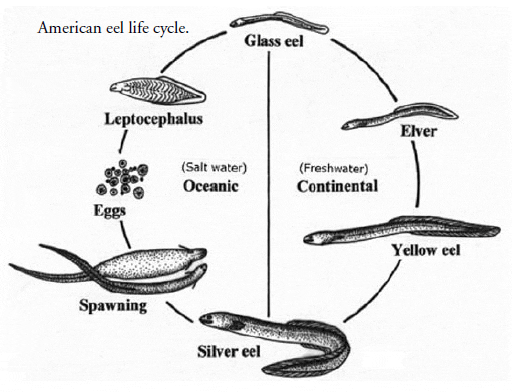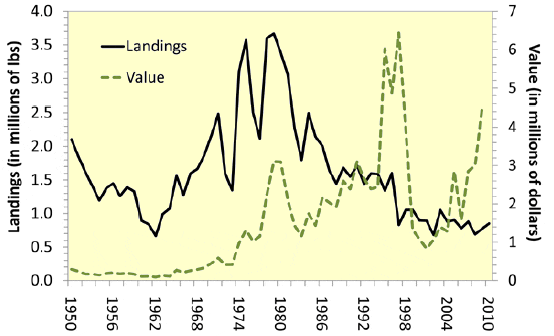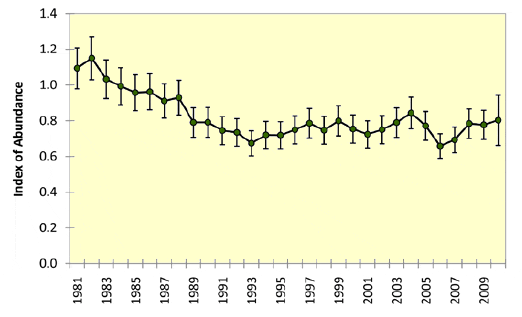American eel are a particularly challenging species to conserve and manage on a
coastwide basis for a number of reasons. Throughout its life-span, from multiple
juvenile life stages through adulthood, American eel will have inhabited and traversed
a wide range of habitats from the Sargasso Sea to estuaries and inland riverine
systems. During this journey, they will have moved through myriad jurisdictions
and management authorities from the high seas to federal government and on to
state governments. The life history of the species, such as late age at maturity and
a tendency of certain life stages to aggregate can make American eels particularly
vulnerable to overharvest.
Over the last two years, there has been a significant increase in the demand for
young eels (called glass eels) due to tighter restrictions on the exportation of European
eels and decreased ability to harvest Japanese eels. Currently, harvest of
elvers is only allowed in Maine and South Carolina. Law enforcement agencies in
all states along the East Coast have been working continuously to monitor and
prevent illegal harvest of glass eels.
Life History

From a biological perspective, American eel are a very mysterious and illusive species.
Information about abundance and status at all life stages, as well as habitat requirements,
is very limited. American eels are catadromous, spending most of their
life in freshwater or estuarine environments, then traveling to the ocean as adults to
reproduce and die. Sexually maturing eels migrate up to 3,000 miles to spawning
grounds located in the Sargasso Sea, an area of the western Atlantic Ocean east of
the Bahamas and south of Bermuda. Spawning events
have never been observed.
Because all mature adult fish
from the entire range come
together in one place and
reproduce, the American
eel population is considered
a panmictic (single) stock.
American eels found along
the eastern coast of Mexico
are from the same population
as eels found in the St.
Lawrence River in Canada.
American eels have a multitude
of life stages: leptocephali,
glass eel, elvers, yellow eel, and silver eel. For up to
a year and a half the Gulf Stream
transports and disperses larval eels,
called leptocephali, along the eastern
coast of Central and North America.
At this stage, the eels are transparent
and no bigger than a stick of gum.
Leptocephali metamorphose into glass
eels as they migrate toward land. The
elver stage occurs when glass eels turn
a brown color and move into brackish
or freshwater. Usually by age two, elvers
make the transition into the yellow eel
stage. Yellow eels will typically establish
a very small home range, and have even
been known to return to their place of
capture if they are displaced. They inhabit
fresh, brackish, and saltwater habitats
where they will feed primarily on invertebrates
and smaller fishes and grow until
they reach sexual maturity.
Sexual maturity can occur any time between
eight and 24 years of age. Females
will grow larger and reach maturity at a
later age than males, particularly in the
northern regions. When yellow eels start
to sexually mature, they begin a downstream
migration toward the Sargasso Sea
spawning grounds. During this migration,
yellow eels metamorphose into the
adult silver eel phase, undergoing several
physiological changes. Adult silver eels are
believed to spawn in the Sargasso Sea during
winter and early spring. It is assumed
they die after spawning.
Commercial & Recreational Fisheries
Commercial landings fluctuate depending on the market price for eel. The American eel fishery primarily targets yellow eels. Eel pots are the most typical gear used; however, weirs, fyke nets, and other fishing methods are also employed. At the silver eel stage, eels are completely focused on migrating and typically do not respond to baited traps. Glass eel fisheries along the Atlantic coast are prohibited in all states except Maine and South Carolina. In recent years, Maine is the only state reporting significant glass eel harvest. Harvest has increased the last few years as the market price has risen to over $2,000 per pound. Although yellow eels were harvested for food historically, todays fishery sells yellow eels primarily as bait for recreational fisheries. Glass eels are exported to Asia to serve as seed stock for aquaculture facilities. Little information is available on targeted recreational fisheries for American eel.

From 1950 to 2010, U.S. Atlantic coast landings ranged from approximately 664,000 pounds in 1962 to 3.67 million pounds in 1979. After an initial decline in the 1950s, landings increased to a peak in the 1970s and 1980s before declining again in the 2000s. The value of U.S. commercial fishery has varied from less than a $100,000 (prior to the 1980s) to a peak of $6.4 million in 1997. Total value increased through the 1980s and 1990s, dropped in the late 1990s, and increased again in the 2000s.
Stock Status
The Commission
conducted a benchmark
stock assessment
for American eel in
2012. Despite the large
number of surveys and
studies available for use
in this assessment, the
American eel stock is
still considered datapoor
because very few
surveys target eels and collect information
on length, age, and sex of the animals
caught. Also, eels have an extremely complex
life history that is difficult to describe
using traditional stock assessment models.
Therefore, two data-poor methods were
used to assess the American eel resource:
trend analyses and model analysis.
Trend analyses found evidence of declining
or, at least, stable abundance of
American eels in the U.S in recent decades.
Regional trend analyses identified
decreasing populations in the Hudson
River and South Atlantic regions, while
analysis from the Chesapeake Bay and
Delaware Bay/Mid-Atlantic Coastal Bays
regions showed no consistent increasing
or decreasing trends. Coastwide model
analysis estimated biomass to be at a
reduced level (see American Eel Stock
Assessment Q & A Sidebar on page 9 for
more information).
American Eel Commercial Landings and Value
Source: ASMFC American Eel Benchmark Stock Assessment, 2012

Both trend and model
analyses indicate that the
American eel stock has
declined in recent decades
and the prevalence
of significant downward
trends in multiple surveys
across the coast is cause for
concern. Significant levels
of harvest in the 1970s is
considered a major factor
contributing to the current low biomass levels, but other factors such
as habitat loss, predation, and disease have
also played a role. Stock status is depleted
and no overfishing determination can
be made at this time based solely on the
trend analyses performed. The ASMFC
American Eel Technical Committee and
Stock Assessment Subcommittee caution
that although commercial fishery landings
and effort in recent times have declined in
most regions (with the possible exception
of the glass eel fishery), current levels of
fishing effort may still be too high given
the additional stressors affecting the stock
such as habitat loss, passage mortality,
and disease as well as potentially shifting
oceanographic conditions. Fishing on all
life stages of eels, particularly young-of-the-year and in-river silver eels migrating
to the spawning grounds, could be particularly
detrimental to the stock, especially
if other sources of mortality (e.g., turbine
mortality, changing oceanographic conditions)
cannot be readily controlled. Management
efforts to reduce mortality on
American eels in the U.S. are warranted.
In 2010, Canada Department of Fisheries
and Oceans (DFO) conducted a stock assessment
on American eels in Canadian
waters and found that region-specific
status indices show abundance relative to
the 1980s is very low for Lake Ontario
and upper St. Lawrence River stock, and
either unchanged or increasing in the Atlantic
Provinces. A joint stock assessment
by both Canada
DFO and the
Commission was
recommended by
the American Eel
Stock Assessment
Subcommittee as
an approach for
the next assessment.
Index of Abundance for Yellow-Phase American Eels Along the Atlantic Coast (30-Year Index). The Error Bars Represent the Standard Errors About the Estimates. Source: ASMFC American Eel Benchmark Stock Assessment, 2012

10-Year Index of Abundance for Young-of-the-Year American Eels Along the Atlantic Coast. The Error Bars Represent the Standard Errors About the Estimates. Source: ASMFC American Eel Benchmark Stock Assessment, 2012

Atlantic Coast Management
American eels
are managed by
the Commission
in territorial seas
and inland waters
along the Atlantic
coast from
Maine to Florida.
Increasing
demand for eel
by Asian markets
and domestic bait
fisheries, coupled
with concern
about declining
eel abundance
and limited assessment
data, spurred development of the first Interstate Fishery
Management Plan for American Eel in the mid-1990s.
The plan, approved in 1999, provided several reasons
why heavy harvest pressure may adversely affect American
eel populations: (1) American eel have a slow rate of
maturation, requiring eight to 24+ years to attain sexual
maturity; (2) glass eel tend to aggregate seasonally
during migration, making them vulnerable to directed
harvest; (3) harvest of yellow eel is a cumulative stress,
over multiple years, on the same yearclass; and (4) all
fishing mortality occurs prior to spawning.
Each state is responsible for implementing management
measures within its jurisdiction to ensure the sustainability
of the American eel population that resides
within state boundaries. The FMP required that all
states and jurisdictions implement an annual young-of-the-year abundance survey by 2001 in order to monitor
annual recruitment. In addition, the FMP required
all states and jurisdictions to establish a minimum
recreational size limit of six inches and a recreational
possession limit of no more than 50 eels per person per
day. Recreational fishermen are not allowed to sell eels
without a state license. Commercial regulations vary
by state but also include a six-inch minimum size limit
with the exception of Maine and South Carolina which
maintain glass eel fisheries. Management measures
stipulate that states and jurisdictions shall maintain
existing (as of 2000) or more conservative fisheries
regulations for all life stages, unless otherwise approved
by the American Eel Management Board.
The greatest hindrance to the development and
implementation of an effective management program
for American eel is the panmictic nature of the stock.
Local, regional, and ocean-wide actions have the ability
to affect the entire stock because there is random
mating within the breeding populationall of the
American eel found from Canada to Central America.
While different agencies have authority over eel in their
jurisdictions, they do not have the ability to alter the
population beyond their management boundaries. The
Commission has begun a working relationship with the
Great Lakes Fishery Commission, which is founded by
a bi-national agreement between the U.S. and Canada,
to facilitate participation and data sharing. In response
to the 2012 American Eel Stock Assessment, the
American Eel Management Board tasked the Technical
Committee to develop management options based on
the recommendations and results in the assessment.
The Management Board will review these options at
the ASMFC Summer Meeting.
July 2012



